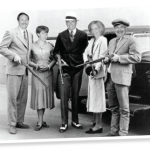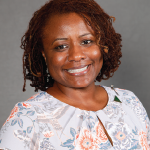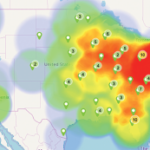
iQoncept / shutterstock.com
I was honored to be invited by Paula to write this column about my aspirations for the ACR’s future. As one might expect, I am also humbled by the prospect of trying to encapsulate the vision that has already been so elegantly provided by ACR leadership and its board of directors: “As the leading authority and trusted partner of rheumatology professionals, the ACR will continually advance the specialty and the future of rheumatology.”
Rather than trying to provide a new vision or indicate a new direction for the ACR, I just wanted to share with you my aspirations for the desired future state, which I shared with the search committee and the board of directors when they were in the process of selecting me as the next executive vice president. My hope is that over the next several years the ACR will continue to modernize, engage and grow.
Most healthcare providers have the same desires when it comes to their professional society. They want an organization that will serve as a global hub of knowledge within the specialty/disease; serve as a central resource in promoting new knowledge through support of innovative research, publications and presentations; and educate providers on best practices to improve health outcomes and increase patient and public awareness.
When it comes to ACR staff, the aspirations are the same, but they are also concerned with increasing membership; increasing attendance at professional meetings; and increasing member engagement in, connection to, and participation in advocacy efforts. Staff have many avenues to success, including better technology to improve ACR products, member and market research to determine the changing member needs and strategic consultants who can help as we partner with various ACR leaders to improve our current offerings. But which of these options is the best, and how will we know what type of innovation is required?
In his book, Competing Against Luck: The Story of Innovation and Customer Choice, Harvard Professor Clay Christensen says far too many companies take a hopeful approach to innovation, because they don’t know how to innovate. “Those who fail to innovate,” he says, “are simply asking the wrong question.” Instead of asking how we can get more members (and non-members) to buy our products or attend our events, the ACR should be asking: What are the needs of our members and non-members? Do our products meet their needs?
To use a more relevant example, you may ask yourself, “Why am I reading this article in The Rheumatologist? What is the job to be done?” It may surprise you that, based on the most recent ACR membership survey, more than 70% of respondents say they read The Rheumatologist. It’s the third most used member benefit behind only the Annual Meeting and the journals.
Some might say the job of The Rheumatologist is to keep members up to date with everything going on at the ACR. Others may say it provides relevant content that will help improve patient care. Still others may just be looking to take a productive break from work. The dilemma is that the answer to this question differs for everyone, and in fact, the multitude of answers that can be given for each of the ACR’s products and services make our jobs challenging and interesting.
Modernize
Members have witnessed several innovations at the ACR over the past few years, including the growth of the Rheumatology Informatics System for Effectiveness (RISE) registry, development of practice measures and exploration of a new rheumatology-specific alternative payment model (APM). Many of these programs were discussed and created by ACR leadership several years before they were launched for the membership. It was the foresight of these leaders, who understood how quality could potentially shape the future of healthcare, that demonstrates they were considering answers to the key question, “What is the job that needs to be done?”
For the next few years, the ACR must be prepared to face many other environmental challenges. One of these is the digital transformation taking place in almost every company and modern organization. To find the answers to the question, “What jobs need to be done?,” we need to operate more like a technology company. As stated in the ACR strategic plan, we need to “become an organization that uses analytics to make better business decisions.”
Analytics and digital transformation can only occur once we have the right kinds of data. Although the ACR has made an investment in a new member database (based on a modern Salesforce platform), the data are not current and may not be the right kinds of data. Once we determine the types of data we need, we will need the cooperation of members to provide the most up-to-date information, so we can “deliver up-to-date and relevant rheumatology information targeted to each member” (ACR Strategic Plan).
Engage
If you think about the ACR like a school bus, you can see it carries many types of people with different backgrounds and levels of experience. One of the jobs to be done is to provide transportation for the journey—everyone is trying to get somewhere. For academicians, the transportation could include research collaboration, scientific publication, training the next generation of rheumatologists and career advancement. For community rheumatologists, it could include the latest data on new therapies, advice from colleagues in other practice settings, evidence-based guidelines or participating in RISE to improve patient care and manage federal reporting requirements.
The idea is that everyone is riding the same bus, benefiting from the same ACR products and services, and they all get something different from their experiences. In the end, everyone is trying to take these experiences back home.
If the ACR is the bus, then member engagement is the fuel that keeps the bus running so we can meet our lofty objectives. By consistently keeping members engaged, we won’t just attract and keep more members, we will have leverage to push through our advocacy agenda, the ability to innovate and create more meaningful educational activities, as well as the ability to meet our mission, “To empower rheumatology professionals to excel in their specialty.”
What does membership engagement look like? In our attempt to become more data driven, we like to measure things, but we need to realize that true engagement is much more than transactional data. That information is important, especially because it is easily tracked and measured, but other activities that provide meaning and purpose to members can be equally significant.
The American Nurses Association (ANA) has developed its own definition of engagement: “Member engagement at ANA is the investment of time, money, attention and participation, by both the association and its members, in order to provide meaningful, long-term, mutually beneficial experiences and relationships that advance the profession.”
It is this investment of time, effort and attention from all our members that will keep the ACR going and fuel its ability to achieve its mission. This engagement is needed from all stakeholders, not just a select few who serve on ACR committees or on ACR leadership. Our challenge then is to come up with a list of jobs to be done for each member segment and a plan to develop meaningful, valuable interactions and experiences that will allow the ACR to advance the interests and needs of each of these stakeholder groups.
September is Rheumatic Disease Awareness Month. Encourage your patients & others to visit www.RDAM.org to learn about rheumatic diseases & sign up to join the Simple Tasks community.
Grow
If we are successful in developing these member experiences and increasing the opportunities for everyone to become more engaged, the ACR will continue to grow—not only in membership, but in the scale of its programs and services, educational programming and overall influence throughout the world.
This growth should include all stakeholders. To foster growth, the ACR and its volunteer-led programs need to become more diverse and include many different perspectives. This includes a wider diversity of members and leaders, and could potentially include more collaboration with other organizations that operate within the rheumatology ecosystem.
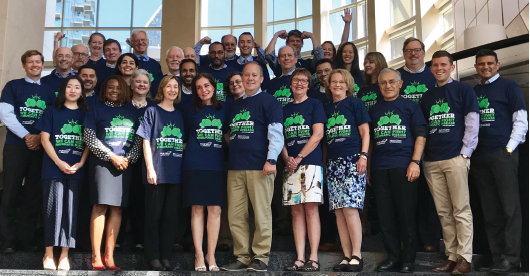
2018–19 ACR board of directors and committee chairs recognize Rheumatic Disease Awareness Month.
To be more inclusive of all stakeholders, the ACR needs to identify those perspectives that are not sufficiently included. Part of the answer is to gather more data about our membership and determine the breadth and depth of these various stakeholder groups. The next step is to gather those groups that are less represented, provide a way for them to participate in the development of ACR programs and products and, ultimately, allow them to become more represented in the volunteer network of the ACR.
It was Peter Drucker, an Austrian-born American management consultant, educator and author, who first expressed the idea that “the customer rarely buys what the company thinks it’s selling.”
Prof. Christensen explains that “understanding the job to be done really helps us in making innovation predictable.” He concludes that “it’s not about how big companies fail, but about how successful companies learn how to grow.”
Now is the time for us to begin developing a list of jobs to be done and helping the ACR’s leadership deliver on its promise to be “here for you so you can be there for your patients.” You can help us develop that list by submitting your ideas on how and why you use ACR products or services. What is the job you want a given ACR product to do? Is it getting that job done? Once we know the answers, we can help improve the experience or create new ones that are more effective in getting the job done.
Submit your ideas to [email protected].
To learn more about Prof. Christensen’s jobs to be done theory, read his interview in the HBR Ideacast from Harvard Business Review.
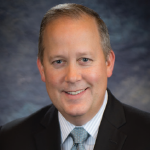 Steven C. Echard is the ACR’s executive vice president, a position he assumed in June. He began his career with the ACR in 1992, serving in several roles. From 2005–2014, he served as executive director of the Rheumatology Research Foundation. He was awarded IOM recognition for completing over 120 hours of graduate-level, nonprofit management courses through the Institute for Organization Management (IOM) program sponsored by the U.S. Chamber of Commerce. He became a Certified Association Executive (CAE) in 1999 through the American Society of Association Executives (ASAE). He currently serves on the ASAE board of directors.
Steven C. Echard is the ACR’s executive vice president, a position he assumed in June. He began his career with the ACR in 1992, serving in several roles. From 2005–2014, he served as executive director of the Rheumatology Research Foundation. He was awarded IOM recognition for completing over 120 hours of graduate-level, nonprofit management courses through the Institute for Organization Management (IOM) program sponsored by the U.S. Chamber of Commerce. He became a Certified Association Executive (CAE) in 1999 through the American Society of Association Executives (ASAE). He currently serves on the ASAE board of directors.
Professionalism Matters
Some members of the ACR may think leaders and staff are throwing things against the wall to see what sticks, but in reality, an entire profession is dedicated to managing and administering trade and professional associations.
All ACR staff belong to the American Society of Association Executives (ASAE), as well as several other professional societies (e.g., American Association of Medical Society Executives, Professional Convention Management Association and others). ASAE, which describes itself as the center for association leadership, boasts more than 50,000 members who share the belief that “associations have the power to transform society for the better.”
ACR members need to know that your staff have an entire network of colleagues who work in other medical and scientific societies and access to organizational research and best practices that help them continue to advance in their careers, improve in their abilities and assist the ACR in achieving great things. When ACR volunteers ask staff to research a problem or develop a list of solutions, these staff can tap into the expertise of hundreds of other senior staff from other medical societies.
